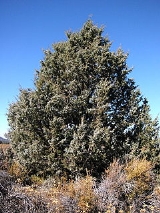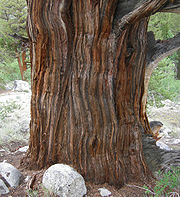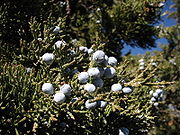
Juniperus occidentalis
Encyclopedia
Juniperus occidentalis (Western Juniper and Sierra Juniper) is a shrub
or tree native to the western United States, growing in mountains at altitudes of 800-3,000 m (rarely down to 100 m).
 The Juniperus occidentalis shoots are of moderate thickness among juniper
The Juniperus occidentalis shoots are of moderate thickness among juniper
s, 1-1.6 mm diameter. The leaves
are arranged in opposite decussate pairs or whorls of three; the adult leaves are scale-like, 1–2 mm long (to 5 mm on lead shoots) and 1-1.5 mm broad. The juvenile leaves (on young seedlings only) are needle-like, 5–10 mm long. The cones
are berry-like, 5–10 mm in diameter, blue-brown with a whitish waxy bloom, and contain one to three seed
s; they are mature in about 18 months. The male cones are 2–4 mm long, and shed their pollen in early spring.
The cones are an important food for several birds, including American Robin
, Phainopepla
and Cedar Waxwing
; these digest the fleshy cone scales and disperse the seeds in their droppings. The plants often bear gall
s caused by the Juniper Tip Midge Oligotrophus betheli (Bibionomorpha
: Cecidomyiidae); these are violet-purple fading to brown, 1–2 cm diameter, with dense modified spreading scale-leaves 6–10 mm long and 2–3 mm broad at the base.
, treated as subspecies
by some botanists:

of California is considered the oldest and largest example at possibly 3000 years old, with a height of 26 m and a diameter of 3.88 m http://www.conifers.org/cu/ju/australis.htm.
and Coast Douglas-fir
. In very exposed positions at high altitude, they can assume a krummholz
habit, growing low to the ground even when mature with a wide trunk (see image at left). Hybrids with Juniperus osteosperma
are occasionally found.
Shrub
A shrub or bush is distinguished from a tree by its multiple stems and shorter height, usually under 5–6 m tall. A large number of plants may become either shrubs or trees, depending on the growing conditions they experience...
or tree native to the western United States, growing in mountains at altitudes of 800-3,000 m (rarely down to 100 m).
Description

Juniper
Junipers are coniferous plants in the genus Juniperus of the cypress family Cupressaceae. Depending on taxonomic viewpoint, there are between 50-67 species of juniper, widely distributed throughout the northern hemisphere, from the Arctic, south to tropical Africa in the Old World, and to the...
s, 1-1.6 mm diameter. The leaves
Leaf
A leaf is an organ of a vascular plant, as defined in botanical terms, and in particular in plant morphology. Foliage is a mass noun that refers to leaves as a feature of plants....
are arranged in opposite decussate pairs or whorls of three; the adult leaves are scale-like, 1–2 mm long (to 5 mm on lead shoots) and 1-1.5 mm broad. The juvenile leaves (on young seedlings only) are needle-like, 5–10 mm long. The cones
Conifer cone
A cone is an organ on plants in the division Pinophyta that contains the reproductive structures. The familiar woody cone is the female cone, which produces seeds. The male cones, which produce pollen, are usually herbaceous and much less conspicuous even at full maturity...
are berry-like, 5–10 mm in diameter, blue-brown with a whitish waxy bloom, and contain one to three seed
Seed
A seed is a small embryonic plant enclosed in a covering called the seed coat, usually with some stored food. It is the product of the ripened ovule of gymnosperm and angiosperm plants which occurs after fertilization and some growth within the mother plant...
s; they are mature in about 18 months. The male cones are 2–4 mm long, and shed their pollen in early spring.
The cones are an important food for several birds, including American Robin
American Robin
The American Robin or North American Robin is a migratory songbird of the thrush family. It is named after the European Robin because of its reddish-orange breast, though the two species are not closely related, with the European robin belonging to the flycatcher family...
, Phainopepla
Phainopepla
The Phainopepla is the most northerly representative of the mainly tropical Central American family Ptilogonatidae, the silky flycatchers.-Description:...
and Cedar Waxwing
Cedar Waxwing
The Cedar Waxwing is a member of the family Bombycillidae or waxwing family of passerine birds. It breeds in open wooded areas in North America, principally southern Canada and the northern United States.-Description:...
; these digest the fleshy cone scales and disperse the seeds in their droppings. The plants often bear gall
Gall
Galls or cecidia are outgrowths on the surface of lifeforms caused by invasion by other lifeforms, such as parasites or bacterial infection. Plant galls are abnormal outgrowths of plant tissues and can be caused by various parasites, from fungi and bacteria, to insects and mites...
s caused by the Juniper Tip Midge Oligotrophus betheli (Bibionomorpha
Bibionomorpha
Bibionomorpha is an infraorder of Nematocera. One of its constituent families, the Anisopodidae, is the presumed sister taxon to the entire suborder Brachycera. Several of the remaining families in the infraorder are former subfamilies of the Mycetophilidae, which has been recently subdivided...
: Cecidomyiidae); these are violet-purple fading to brown, 1–2 cm diameter, with dense modified spreading scale-leaves 6–10 mm long and 2–3 mm broad at the base.
Varieties
There are two Juniperus occidentalis varietiesVariety (biology)
In botanical nomenclature, variety is a taxonomic rank below that of species: as such, it gets a three-part infraspecific name....
, treated as subspecies
Subspecies
Subspecies in biological classification, is either a taxonomic rank subordinate to species, ora taxonomic unit in that rank . A subspecies cannot be recognized in isolation: a species will either be recognized as having no subspecies at all or two or more, never just one...
by some botanists:
- Juniperus occidentalis var. occidentalis Western Juniper. Southeast Washington, eastern and central OregonOregonOregon is a state in the Pacific Northwest region of the United States. It is located on the Pacific coast, with Washington to the north, California to the south, Nevada on the southeast and Idaho to the east. The Columbia and Snake rivers delineate much of Oregon's northern and eastern...
, southwest IdahoIdahoIdaho is a state in the Rocky Mountain area of the United States. The state's largest city and capital is Boise. Residents are called "Idahoans". Idaho was admitted to the Union on July 3, 1890, as the 43rd state....
, northeastern CaliforniaCaliforniaCalifornia is a state located on the West Coast of the United States. It is by far the most populous U.S. state, and the third-largest by land area...
and extreme northwest NevadaNevadaNevada is a state in the western, mountain west, and southwestern regions of the United States. With an area of and a population of about 2.7 million, it is the 7th-largest and 35th-most populous state. Over two-thirds of Nevada's people live in the Las Vegas metropolitan area, which contains its...
, north of 40° 30' N latitude, east of the Cascade RangeCascade RangeThe Cascade Range is a major mountain range of western North America, extending from southern British Columbia through Washington and Oregon to Northern California. It includes both non-volcanic mountains, such as the North Cascades, and the notable volcanoes known as the High Cascades...
. A shrub or small tree 4–15 m tall. Exceptionally tall specimens can be found in the John Day area of Oregon well in excess of 26–28 m tall (80–90 feet+) competing for sunlight among Ponderosa Pines at the bottom of some deep side canyons, but on open and barren ground 4–15 m with a bushier growth habit is more common. Cones 7–10 mm diameter. About 50% of plants are monoeciousPlant sexualityPlant sexuality covers the wide variety of sexual reproduction systems found across the plant kingdom. This article describes morphological aspects of sexual reproduction of plants....
with both sexes on the same plant, 50% dioeciousPlant sexualityPlant sexuality covers the wide variety of sexual reproduction systems found across the plant kingdom. This article describes morphological aspects of sexual reproduction of plants....
, producing cones of only one sex.
- Juniperus occidentalis var. australis Sierra Juniper. California and westernmost Nevada, south of 40° 30' N latitude in the Sierra Nevada and San Bernardino MountainsSan Bernardino MountainsThe San Bernardino Mountains are a short transverse mountain range north and east of San Bernardino in Southern California in the United States. The mountains run for approximately 60 miles east-west on the southern edge of the Mojave Desert in southwestern San Bernardino County, north of the...
. A medium-sized tree 12–26 m tall with a stout trunk up to 3 m diameter. Cones 5–9 mm diameter. Most plants dioecious, but about 5-10% are monoecious.

Ancient tree
The Bennett Juniper in the Stanislaus National ForestStanislaus National Forest
Stanislaus National Forest contains in four counties in the Sierra Nevada Mountains of Northern California. It was established on February 22, 1897, making it one of the oldest national forests...
of California is considered the oldest and largest example at possibly 3000 years old, with a height of 26 m and a diameter of 3.88 m http://www.conifers.org/cu/ju/australis.htm.
Habitat
Juniperus occidentalis usually occurs on dry, rocky sites where there is less competition from larger species like Ponderosa PinePonderosa Pine
Pinus ponderosa, commonly known as the Ponderosa Pine, Bull Pine, Blackjack Pine, or Western Yellow Pine, is a widespread and variable pine native to western North America. It was first described by David Douglas in 1826, from eastern Washington near present-day Spokane...
and Coast Douglas-fir
Coast Douglas-fir
Pseudotsuga menziesii, known as Douglas-fir, Oregon Pine, or Douglas spruce, is an evergreen conifer species native to western North America. Its variety Pseudotsuga menziesii var. menziesii, also known as coast Douglas-fir grows in the coastal regions, from west-central British Columbia, Canada...
. In very exposed positions at high altitude, they can assume a krummholz
Krummholz
Krummholz or Krumholtz formation — also called Knieholz — is a particular feature of subarctic and subalpine tree line landscapes. Continual exposure to fierce, freezing winds causes vegetation to become stunted and deformed...
habit, growing low to the ground even when mature with a wide trunk (see image at left). Hybrids with Juniperus osteosperma
Juniperus osteosperma
Juniperus osteosperma is a shrub or small tree reaching 3-6 m tall. It is native to the southwestern United States, in Utah, Nevada, Arizona, western New Mexico, western Colorado, Wyoming, southern Montana, southern Idaho and eastern California...
are occasionally found.

